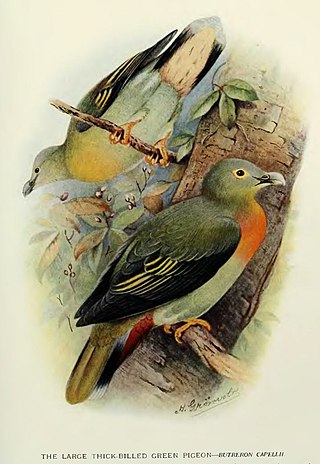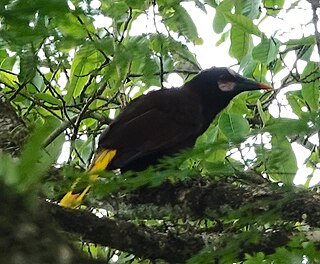
The Nightcap National Park is a national park situated within the Nightcap Range in the Northern Rivers region of New South Wales, Australia. The 8,080-hectare (20,000-acre) park was created in April 1983 and is situated 35 kilometres (22 mi) north of Lismore. The park was established following campaigns and blockades against logging at Terania Creek, Grier's Scrub and Mount Nardi between 1979 and 1982. Sections of the Whian Whian state forest were added to it following blockading and campaigning in 1998. The national park is classed by the IUCN World Commission on Protected Areas as Category II and is part of the Shield Volcano Group of the World Heritage Site Gondwana Rainforests of Australia inscribed in 1986 and added to the Australian National Heritage List in 2007.

The hairy-eared dwarf lemur, or hairy-eared mouse lemur, is one of the most scarcely known lemurs. A. trichotis is a nocturnal lemur that is endemic to Madagascar. It was originally named by Albert Günther in 1875 as Cheirogaleus trichotis as part of the Cheirogaleidae family, or the dwarf lemurs. In 1967 Petter-Rousseaux and Petter reassigned the lemur to its own genus and is the now only member of the genus Allocebus. The hairy-eared dwarf lemur was thought to be extinct until its rediscovery in 1989 in a northeastern primary lowland rainforest. The population of these mammals is shown to be severely decreasing and largely fragmented throughout Northern and Eastern Madagascar rainforests; most likely due to hunting, trapping, slash-and-burn agriculture as well as habitat fragmentation.

The brown spider monkey or variegated spider monkey is a critically endangered species of spider monkey, a type of New World monkey, from forests in northern Colombia and northwestern Venezuela.

The Congolian rainforests are a broad belt of lowland tropical moist broadleaf forests which extend across the basin of the Congo River and its tributaries in Central Africa.

The Madagascar dry deciduous forests represent a tropical dry forest ecoregion situated in the western and northern part of Madagascar. The area has high numbers of endemic plant and animal species but has suffered large-scale clearance for agriculture. They are among the world's richest and most distinctive dry forests and included in the Global 200 ecoregions by the World Wide Fund. The area is also home to distinctive limestone karst formations known as tsingy, including the World Heritage Site of Bemaraha.

The red-legged pademelon is a species of small macropod found on the northeastern coast of Australia and in New Guinea. In Australia it has a scattered distribution from the tip of Cape York Peninsula in Queensland to around Tamworth in New South Wales. In New Guinea it is found in south central lowlands.

The wildlife of Cameroon is composed of its flora and fauna. Bordering Nigeria, it is considered one of the wettest parts of Africa and records Africa's second highest concentration of biodiversity. To preserve its wildlife, Cameroon has more than 20 protected reserves comprising national parks, zoos, forest reserves and sanctuaries. The protected areas were first created in the northern region under the colonial administration in 1932; the first two reserves established were Mozogo Gokoro Reserve and the Bénoué Reserve, which was followed by the Waza Reserve on 24 March 1934. The coverage of reserves was initially about 4 percent of the country's area, rising to 12 percent; the administration proposes to cover 30 percent of the land area.

The slender lorises (Loris) are a genus of loris native to India and Sri Lanka. The genus comprises two species, the red slender loris found in Sri Lanka and the gray slender loris from Sri Lanka and India. Slender lorises spend most of their life in trees, traveling along the tops of branches with slow and precise movements. They are found in tropical rainforests, scrub forests, semi-deciduous forests, and swamps. The primates have lifespans of approximately 15 years and are nocturnal. Slender lorises generally feed on insects, reptiles, plant shoots, and fruit.

The large green pigeon is a species of bird in the family Columbidae. It is found in Brunei, Indonesia, Malaysia, Myanmar, and Thailand. Its natural habitat is subtropical or tropical moist lowland forests. It is threatened by habitat loss.

The Baudó oropendola is a species of bird in the family Icteridae. It is endemic to Colombia. Its natural habitat is subtropical or tropical moist lowland forests, which are threatened by destruction. As it is only known from a small number of locations, its conservation status has been assessed as "endangered" by the IUCN.

The black-spotted cuscus is a species of marsupial in the family Phalangeridae. It is among the largest members of the family, only being surpassed by the bear cuscus. It is a relatively colourful species found in forests of northern New Guinea. It is threatened by hunting and habitat loss, and has already disappeared from large parts of its range. Consequently, it is rated as Critically Endangered by IUCN.

The dwarf scaly-tailed squirrel is a species of rodent in the family Anomaluridae. It is found in Cameroon, Central African Republic, Republic of the Congo, Democratic Republic of the Congo, Equatorial Guinea, Gabon and Uganda. The species is nocturnal and arboreal and lives in subtropical or tropical lowland rainforest. Membranes attached to its limbs and tail enable it to glide between trees. This squirrel is currently not considered to be threatened by habitat destruction; "much of the habitat within parts of the known range of this species is relatively intact, and the species is unlikely to be experiencing any significant declines."

The Kimberley tropical savanna is a tropical and subtropical grasslands, savannas, and shrublands ecoregion in northwestern Australia, covering portions of Western Australia and the Northern Territory south of the Timor Sea.

The Susan Island Nature Reserve is a protected 20-hectare (49-acre) reserve nature reserve located at the western (upstream) end of the 90ha Susan Island, a 3km long x 420m wide river island, that is located in the Clarence River, in the Northern Rivers region of New South Wales in eastern Australia near the centre of Grafton. The rainforest of the nature reserve and adjoining crown land is a rare 19-hectare (47-acre) example of sub tropical lowland rainforest on floodplain, and is listed under the NSW Biodiversity Conservation Act as an Endangered Ecological Community.

The Cross River National Park is a national park of Nigeria, located in Cross River State, Nigeria. There are two separate sections, Okwangwo and Oban . The park has a total area of about 4,000 km2, most of which consists of primary moist tropical rainforests in the North and Central parts, with mangrove swamps on the coastal zones. Parts of the park belong to the Guinea-Congolian region, with a closed canopy and scattered emergent trees reaching 40 or 50 meters in height.

The Stotts Island Nature Reserve is a protected nature reserve containing the Stotts Island, a river island, that is located in the Tweed River, in the Northern Rivers region of New South Wales in eastern Australia. The 141-hectare (350-acre) reserve is situated near Tweed Heads and 12 kilometres (7.5 mi) northeast of Murwillumbah.

The Luzon rain forest is a tropical moist broadleaf forest ecoregion on the island of Luzon. Luzon is the largest island in the Philippines, and the Luzon rain forest is the most extensive rainforest ecoregion of the country. The ecoregion includes the lowlands of Luzon and neighboring islands below 1000 meters elevation. Very little of the original rainforest remains, and the status of this area is critical/endangered.

Sainte Luce Reserve is a nature reserve in south-east Madagascar and part of one of the last remaining intact coastal rainforests in the country. The reserve is private, and has been managed by the Filana Association since 2010. It forms part of the greater Sainte Luce rainforest, which is approximately 15 km long and varies from 100m to 700m wide. The reserve itself is approximately 1 km long and averages 300m across.

The Guianan moist forests (NT0125) is an ecoregion in the east of Venezuela, north of Brazil and the Guyanas. It is in the Amazon biome. The climate is hot and humid, with two rainy seasons each year. As of 1996 the tropical rainforest habitat was relatively intact, although there were mounting threats from illegal logging and gold mining.

The Chocó–Darién moist forests (NT0115) is a largely forested, tropical ecoregion of northwestern South America and southern Central America. The ecoregion extends from the eastern Panamanian province of Darién and the indigenous region of Guna Yala to almost the entirety of Colombia's Pacific coast, including the departments of Cauca, Chocó, Nariño and Valle del Cauca.





















